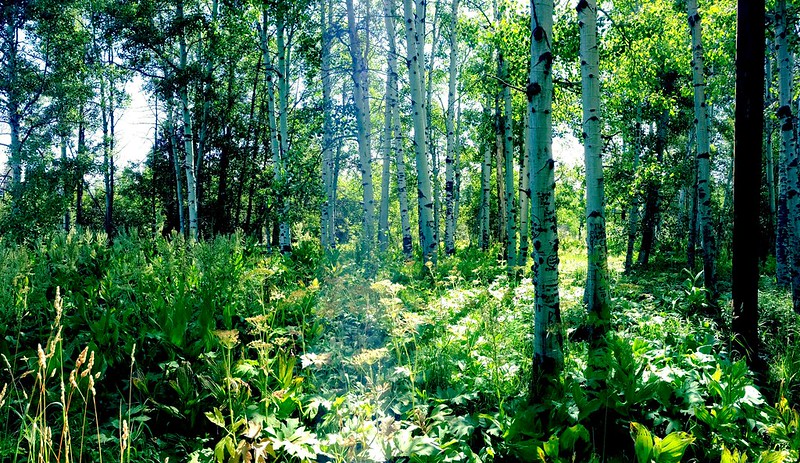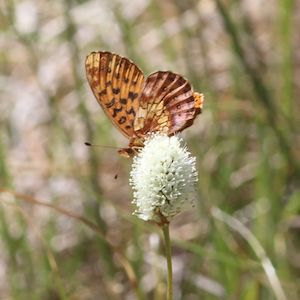Picture an aspen tree. You probably envision a powdery white trunk with trembling green or gold leaves. But scientists say it’s more accurate to think of an aspen as a vast network of roots, 1-20 acres in size, concealed underground until a beam of sunlight awakens it. Sun triggers the aspen roots below to send up shoots that become trees. A stand of aspen trees is generally a single organism, or clone, the vast majority of which lays underground.

Aspen suckers grow in a gap made by tree fall on the project site.
A healthy aspen stand includes trees–more accurately known as stems–of varying ages. Fifty to 100-year-old mature stems make up the overstory, multiple cohorts of younger stems make up the midstory, while small suckers push up from the underground roots. Over time, aspen stands may be taken over by conifers, but the roots- which can extend as far as 100 ft from the nearest stem- remain and can lie dormant for years (as long at least one above-ground stem, or tree, persists). If a gap opens in the conifer canopy, the roots are ready to send up new aspen “trees” in the form of suckers.
What creates gaps in the conifer forest? Disturbance is an important part of maintaining a diverse forest structure and without it, aspen stands will not persist. Treefalls and other disturbances can create small gaps, but forest fires are the big opportunity for aspen in the arid West. When fires are suppressed, as they have been in the Sierra Nevada, aspens don’t have an opportunity to grow robust stands. Drought and climate change have also imperiled aspens in the Sierra Nevada. This is unfortunate not just because aspens are remarkable trees, but because aspen stands are hotspots of biodiversity.
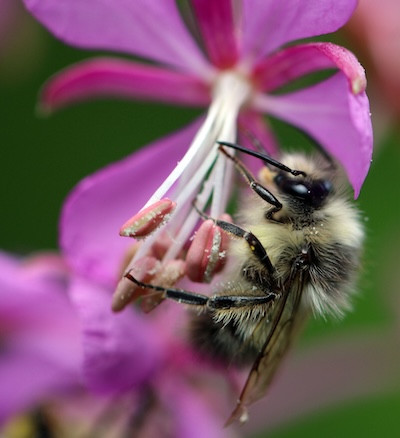
A fuzzy-horned bumble bee (Bombus Mixtus.) Photo by Peter Pearsall/USFWS.
Aspen stands typically have a lusher understory with greater plant diversity compared to conifer forests. Wildflowers and grasses provide food for pollinators like butterflies, hummingbirds, and bumble bees, including White-shouldered Bumble Bee, Yellow Head Bumble Bee, and Fuzzy-horned Bumble Bee in the Sierra Nevada. This herbaceous understory also provides seeds for small birds and mammals, and cover for deer, especially during fawning. Sierra Nevada breeding bird species like Warbling Vireo, Red-breasted Sapsucker, and MacGillivray’s Warbler all thrive in aspen stands. Healthy aspen stands can also reduce fire severity under some conditions. “They serve as a kind of speed bump for fires,” says Loffland, “because they, like meadows, generally retain higher soil moisture and humidity levels and don’t burn with as much intensity as conifers.”
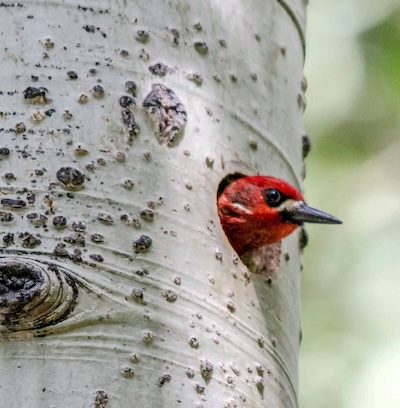
A Red-breasted Sapsucker peeks out of its nest hole in an aspen trunk. Photo by Aaron Bugdor.
IBP biologist Helen Loffland, who is our meadow bird specialist and also leads our bumble bee work, says aspen groves and meadows have many commonalities. “In addition to retaining more water than many surrounding communities, meadows and aspen groves support many of the same understory flowers and grasses. Aspen are also closely related to willows which are usually the dominant riparian shrub in meadow systems.” Helen grew up in California and spent much of her childhood on an undeveloped ranch in the Sierra Nevada foothills. She has lived in Amador County, CA near the Eldorado National Forest for 33 years. Through Helen, IBP became a member of the Amador-Calaveras Consensus Group, a community-based organization that works to create fire-safe communities, healthy forests and watersheds, and sustainable local economies.
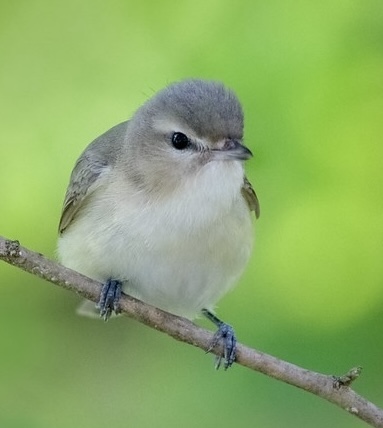
Warbling Vireo. Photo by Steven Kersting.
When the US Forest Service and ACCG were planning largescale forest thinning treatments (removal of conifers) on Eldorado and Stanislaus forests in Amador and Calaveras counties, Loffland and her partners at the Upper Mokelumne River Watershed Authority (UMRWA) saw an opportunity to leverage the planned conifer removal to benefit and restore aspen stands. If thinning (and potentially prescribed fire) could be targeted to the areas surrounding existing patches of struggling aspen, it could enable these patches to regain vigor and possibly to even expand to fill their larger historic footprint. Together they successfully applied for a California State Wildlife Conservation Board grant which looks to fund work that is a win-win for the environment and fire safety.
Loffland and UMRWA developed a project to ground-truth and map existing aspen stands- which are typically too small to show up on aerial photography- across the Upper Mokelumne River Watershed and adjacent areas of the upper South Fork American, Cosumnes, and Tuolumne River watersheds, so that the land managers could target them for conifer removal or other restoration treatments. In addition to mapping, IBP crews also assessed aspen stand condition (i.e. aspen stem density across age classes, conifer density, and browse intensity) and surveyed bumble bees and birds so that stand condition and wildlife habitat use could be compared before and after conifer removal. IBP and UMRWA are using this information to create a GIS database that prioritizes Aspen stands for treatment, and developing a “shovel ready” restoration plan for 300 acres of high priority stands.

A Great Gray Owl perches on an aspen branch. Photo by Bryant Olsen.
“In getting out on the ground and mapping the boundaries of over 1,000 acres of aspen we have found some large and healthy stands in a few places, but the vast majority of stands have died back to smaller isolated patches (median size was 1/3 of an acre), with very few stems in the ‘teenage' age classes. Despite the fact that most stands are heavily overtopped by mature conifers, we found that even small additions of aspen are associated with greater abundance of Warbling Vireos.”
Conifer removal in the first round of aspen stands to be treated is expected to start in 2025. After the treatment, Loffland plans to reassess aspen stand condition and resurvey for pollinators and birds to determine if conifer removal benefitted aspen stands and the wildlife that uses them. This project would not have happened if it weren’t for Loffland’s deep involvement in her community as well as her expertise in habitat restoration and bird conservation. “This project has been really wonderful for me because its basically in my backyard, and almost every time I go searching for aspen I find a new patch…Its like an easter egg hunt every day,” says Loffland. “I’m not gonna lie, I spend a lot of time with maps and aerial imagery planning my next aspen adventure.”


